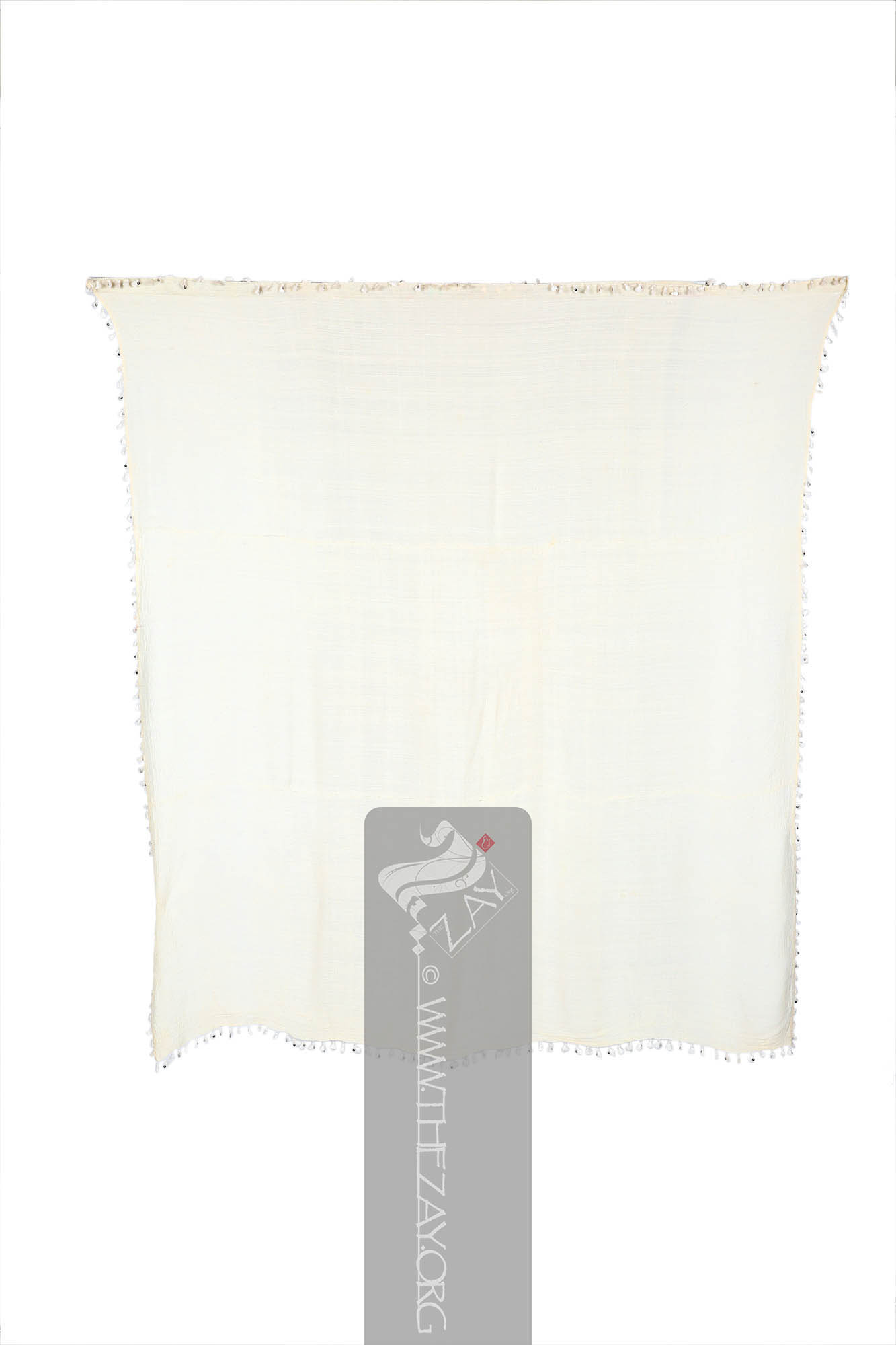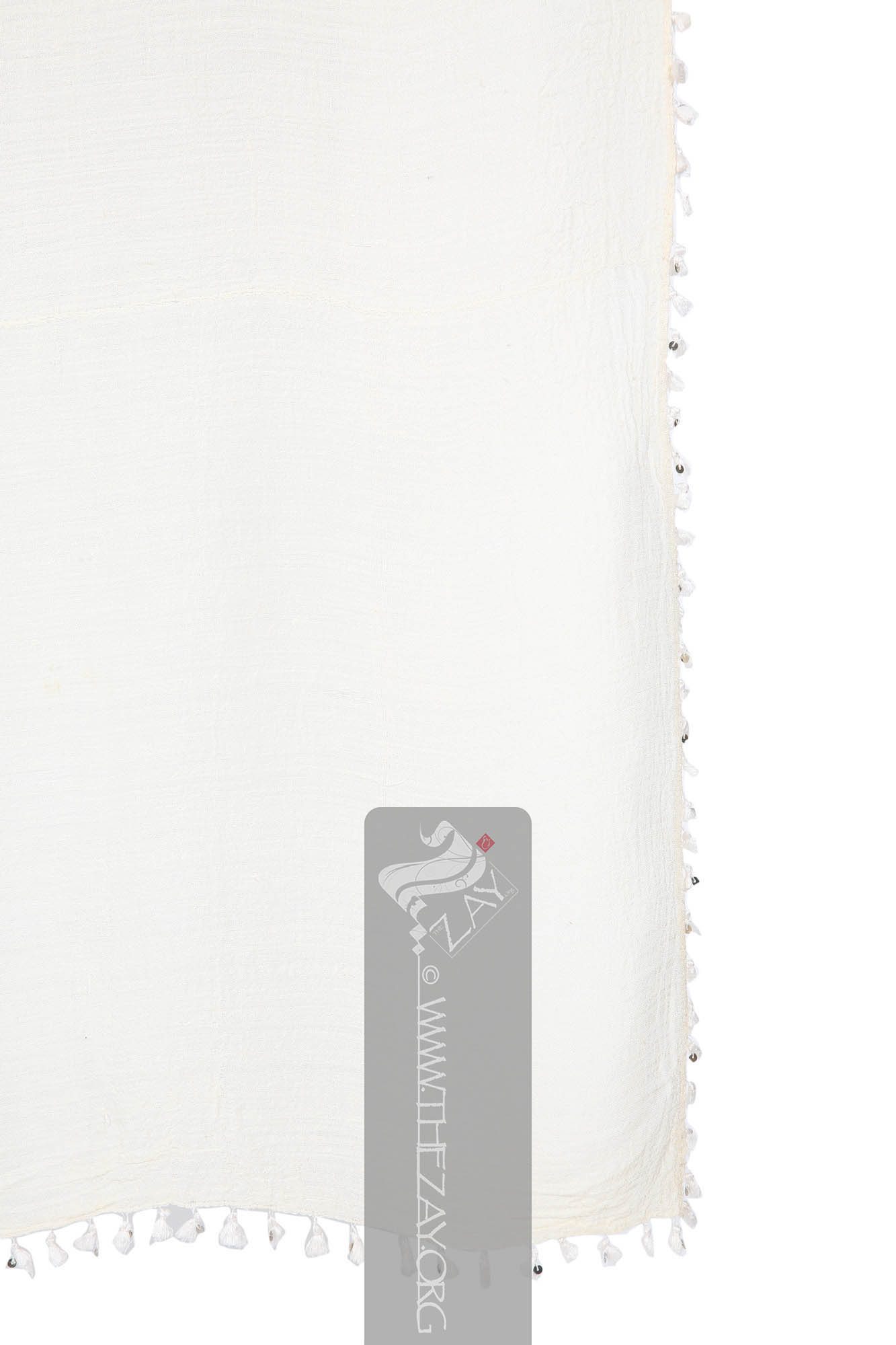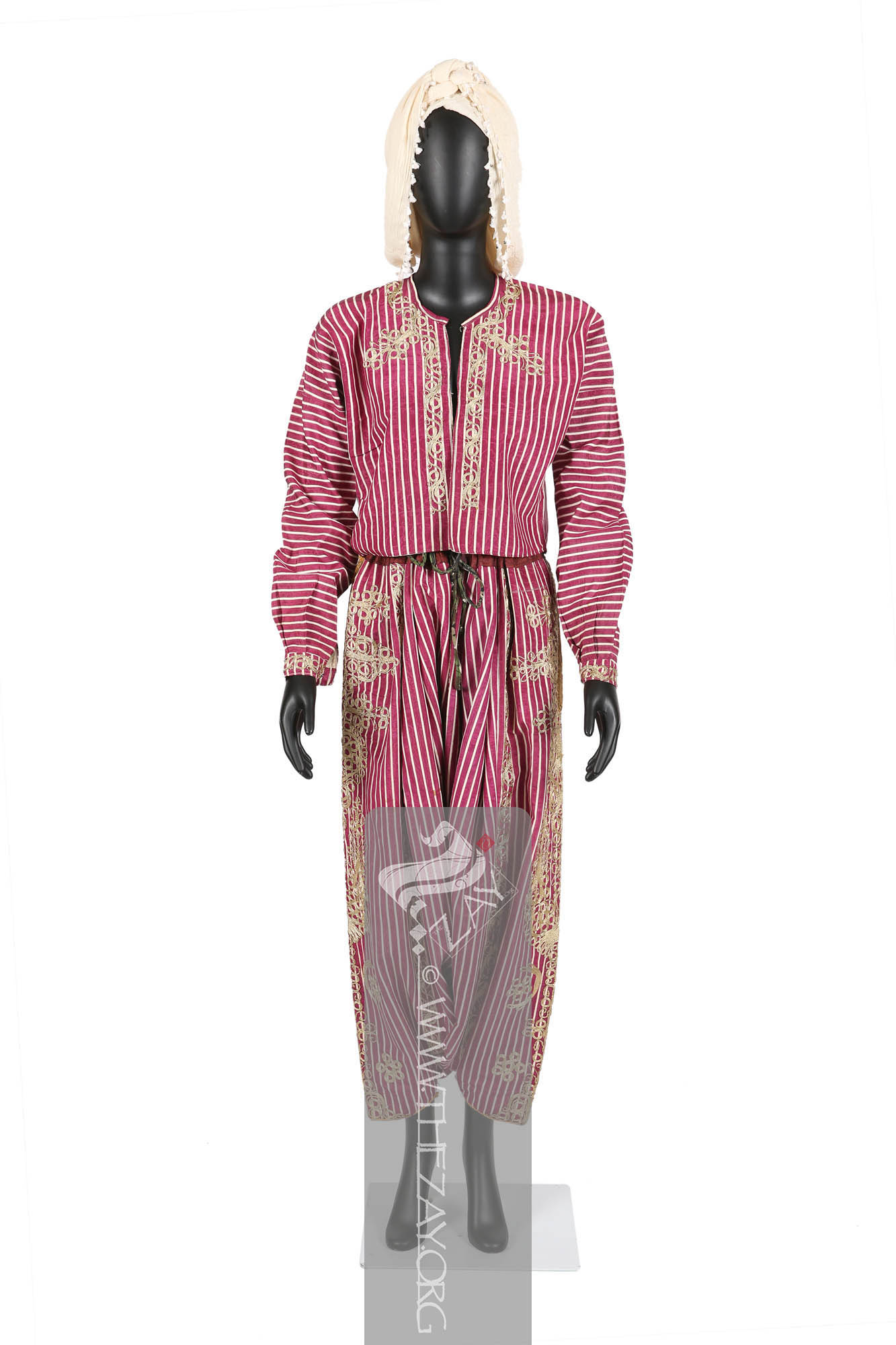Object NotePart of an ensemble with two other pieces also part of the collection (
ZI2020.500641 ASIA and
ZI2020.500641a ASIA).
Object History This piece of garment was purchased by
Dr. Reem Tariq
Ṭariq: (Arabic; Synonym: tulle_bi_talli
Tūlle_bi_tallī: (French: Tulle – a city in France where fine material for veil was first made; Turkish: tel – wire; Synonym: tariq; talli; badla; khus_dozi ), series of small metal knots made on a woven net ground as embellishment. The term is commonly used in the North African Arab region specifically in Egypt.
; talli; badla; khus_dozi ), series of small metal knots made on a woven net ground as embellishment. The term is commonly used in the Levant Arab region specifically in Lebanon.
El Mutwalli
Dr. Reem Tariq
Ṭariq: (Arabic; Synonym: tulle_bi_talli
Tūlle_bi_tallī: (French: Tulle – a city in France where fine material for veil was first made; Turkish: tel – wire; Synonym: tariq; talli; badla; khus_dozi ), series of small metal knots made on a woven net ground as embellishment. The term is commonly used in the North African Arab region specifically in Egypt.
; talli; badla; khus_dozi ), series of small metal knots made on a woven net ground as embellishment. The term is commonly used in the Levant Arab region specifically in Lebanon.
el Mutwallī: Founder (CEO) of the Zay
Zay: (Arabic: costume, Pl. azyaā’), a set of clothes in a style typical of a particular country or historical period. Initiative, a public figure, speaker and author. An expert curator and consultant in Islamic art and architecture, interior design, historic costume, and UAE heritage. as a set of ensembles from an independent dealer, in Istanbul in 2020 to add to and enhance The
Zay
Zay: (Arabic: costume, Pl. azyaā’), a set of clothes in a style typical of a particular country or historical period. Initiative Collection.
Object Features This is a rectangular ivory head cover or
scarf
Scarf: (English), usually a rectangular piece of cloth loosely worn over the shoulders, upper body and arms, and sometimes also over the head. (
yazma
Yazma: (Turkish), a lightweight, square-shaped Turkish traditional scarf made of cotton or silk and often adorned with vibrant printed, or hand drawn colourful patterns and delicate needle lace trimmings (oya). ) made of cotton
gauze
Gauze: (English), very fine wire mesh transparent fabric of silk, linen, or cotton. fabric. The field of the piece is completely blank with no embellishment. However, it has ivory silk
floss
Floss: (Old French: flosche – nap of velvet), is a type of silk fibre obtained from the cocoons of wild silkworms. It is characterized by its long, fluffy fibers that are not tightly woven, making it ideal for use in various textile applications such as embroidery, lace-making, and sewing. pompoms attached to the edges that are highlighted with metal sequins possibly made of silver.
In certain parts of Turkey, such panels of fabric can also be referred to as (
mandil_yazma_mahrama
Mandīl_yazma_maḥramah: (Arabic: mandil – handkerchief; Turkish: yazma – scarf
Scarf: (English), usually a rectangular piece of cloth loosely worn over the shoulders, upper body and arms, and sometimes also over the head.; Arabic: mahramah – handkerchief; Synonym: yazma
Yazma: (Turkish), a lightweight, square-shaped Turkish traditional scarf made of cotton or silk and often adorned with vibrant printed, or hand drawn colourful patterns and delicate needle lace trimmings (oya). _yemeni, mahramah), often a rectangular piece of printed or patterned fabric used as head cover and handkerchief by Ottoman women. ) or (
yazma_yemeni
Yazma_yemeni: (Turkish: yazma – scarf; Arabic: yemeni – possibly from Yemen a sovereign Arab country located in the Arabian Peninsula; Synonym: mendil_yazma_makrama, mahramah), often a rectangular piece of printed or patterned fabric used as head cover and handkerchief by Ottoman women. ). However, these fabrics which are more akin to kerchiefs than scarves or traditional Turkish
yazma
Yazma: (Turkish), a lightweight, square-shaped Turkish traditional scarf made of cotton or silk and often adorned with vibrant printed, or hand drawn colourful patterns and delicate needle lace trimmings (oya). , are typically rectangular in shape with printed patterns.
The various names or terms for these fabrics reflect the cross-cultural exchanges between the Arab world and the Ottoman regions. The origin of the term
yazma_yemeni
Yazma_yemeni: (Turkish: yazma – scarf; Arabic: yemeni – possibly from Yemen a sovereign Arab country located in the Arabian Peninsula; Synonym: mendil_yazma_makrama, mahramah), often a rectangular piece of printed or patterned fabric used as head cover and handkerchief by Ottoman women. is uncertain, but some sources suggest that the earliest kerchiefs were possibly made of block_printed fabrics imported from Yemen. As printing facilities were later established within the empire, the term was generalised for any printed fabric.
Over time, the use of the terms
yazma_yemeni
Yazma_yemeni: (Turkish: yazma – scarf; Arabic: yemeni – possibly from Yemen a sovereign Arab country located in the Arabian Peninsula; Synonym: mendil_yazma_makrama, mahramah), often a rectangular piece of printed or patterned fabric used as head cover and handkerchief by Ottoman women. or
mandil_yazma_mahrama
Mandīl_yazma_maḥramah: (Arabic: mandil – handkerchief; Turkish: yazma – scarf
Scarf: (English), usually a rectangular piece of cloth loosely worn over the shoulders, upper body and arms, and sometimes also over the head.; Arabic: mahramah – handkerchief; Synonym: yazma
Yazma: (Turkish), a lightweight, square-shaped Turkish traditional scarf made of cotton or silk and often adorned with vibrant printed, or hand drawn colourful patterns and delicate needle lace trimmings (oya). _yemeni, mahramah), often a rectangular piece of printed or patterned fabric used as head cover and handkerchief by Ottoman women. declined as scarves adorned with painted or printed patterns and (
oya
Oyā: (Turkish), refers to various forms of narrow needle lace trimmings common to eastern and southern Mediterranean regions and parts of Armenia. Believed to be a derivative of Venetian lace it is considered an indelible part of the traditional craft of Türkiye today. ) trimmings became popular. These were simply, called
yazma
Yazma: (Turkish), a lightweight, square-shaped Turkish traditional scarf made of cotton or silk and often adorned with vibrant printed, or hand drawn colourful patterns and delicate needle lace trimmings (oya). , retained a square shape instead of being rectangular, and were primarily used as headgear.
Links
- Cangökçe, Hadiye, et al. Osmanlı İmparatorluğu’nun Son Döneminden Kadın Giysileri = Women’s Costume of the Late Ottoman Era from the Sadberk Hanım Museum Collection. Sadberk Hanım Museum, 2010.
- Küçükerman, Önder, and Joyce Matthews. The Industrial Heritage of Costume Design in Turkey. GSD Foreign Trade Co. Inc, 1996.
- AĞAÇ, Saliha, and Serap DENGİN. “The Investigation in Terms of Design Component of Ottoman Women Entari
: (Turkish; Synonym: Antari), a traditional Turkish long jacket-like unisex garment worn during the Ottoman era. It often featured an open front with long sleeves and was worn over an undershirt and a pair of trousers and was sometimes layered by a short waist or hip-length jacket. in 19th Century and Early 20th Century.” International Journal of Science Culture and Sport (IntJSCS), vol. 3, no. 1, Mar. 2015, pp. 113–125. https://dergipark.org.tr/tr/download/article-file/91778
- Parker, Julianne. “OTTOMAN AND EUROPEAN INFLUENCE IN THE NINTEENTH-CENTURY BRIDAL COLLECTION OF THE AZEM PALACE, DAMASCUS, SYRIA.” Journal of Undergraduate Research: Brigham Young University, 18 Sept. 2013. http://jur.byu.edu/?p=6014
- Koç, Adem. “The Significance and Compatibility of the Traditional Clothing-Finery Culture of Women in Kutahya in Terms of Sustainability.” Milli Folklor , vol. 12, no. 93, Apr. 2012. 184. https://www.millifolklor.com/PdfViewer.aspx?Sayi=93&Sayfa=181
- Micklewright, Nancy. “Late-Nineteenth-Century Ottoman Wedding Costumes as Indicators of Social Change.” Muqarnas, vol. 6, 1989, pp. 161–74. JSTOR, https://doi.org/10.2307/1602288. Accessed 13 July 2023.
- Micklewright, Nancy. “Looking at the Pst: Nineteenth Century Images of Constantinople and Historic Documents.” Expedition, vol. 32, no. 1, pp. 24–32. https://www.penn.museum/documents/publications/expedition/pdfs/32-1/micklewright.pdf
- Ozgen, Ozlen, et al. “Henna Ritual Clothing in Anatolia from Past to Present: An Evaluation on Bindalli.” Textile Society of America Symposium Proceedings, 2021, https://doi.org/10.32873/unl.dc.tsasp.0122.
- Hickman, Patricia Lynette. “Turkish Oya
Oyā: (Turkish), refers to various forms of narrow needle lace trimmings common to eastern and southern Mediterranean regions and parts of Armenia. Believed to be a derivative of Venetian lace it is considered an indelible part of the traditional craft of Türkiye today. .” University of California, Berkeley, Dec, 1977. https://digitalassets.lib.berkeley.edu/envi/turkish_oya_v2.pdf






